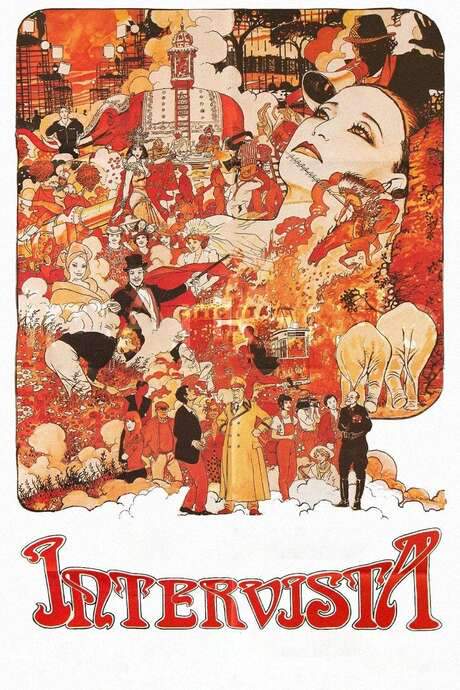Warning: spoilers below!
Haven’t seen Intervista yet? This summary contains major spoilers. Bookmark the page, watch the movie, and come back for the full breakdown. If you're ready, scroll on and relive the story!
Intervista (1987) – Full Plot Summary & Ending Explained
Read the complete plot breakdown of Intervista (1987), including all key story events, major twists, and the ending explained in detail. Discover what really happened—and what it all means.
Federico Fellini invites viewers behind the scenes at Cinecittà, where a nighttime set is readied for a sequence he dubs “the prisoner’s dream.” In this moment, his hands search for a way out of a dark tunnel, mirroring the aging director’s own sense of time catching up with him. As night gives way to morning, the tour resumes and the mood shifts from dreamlike hazard to documentary curiosity. The crew walks past glossy, ever-moving TV commercials in production, while the casting director introduces four young actors chosen to embody Karl Rossmann, the lead from the studio’s imagined adaptation of Kafka’s Amerika. On-screen, the famed Nadia Ottaviani appears as the custodian of Cinecittà, a brief and charming distraction as she slips away to pick dandelions for herbal tea, adding a touch of whimsy to the earnest hustle of film-making. The assistant director, Maurizio Mein, corrals the team on location at the Casa del Passeggero, a once-cheap hotel transformed into a drugstore set, a location Fellini longs to reclaim from a past visit to Cinecittà in 1938 during the Fascist era.
The narrative then folds time upon itself as Fellini interacts with his younger self, played by the rising actor Sergio Rubini. Their dialogue and staging dramatize the tension between memory and invention, as the team rebuilds the Casa del Passeggero façade elsewhere in Rome and a fake tramway whisks Fellini’s younger self from an imagined American West, through a moment with Indian warriors on a cliff, to a herd of elephants off a distant Ethiopian coast. This dreamlike travelogue leads to Cinecittà proper, where Fellini seeks out Katya, a stand-in for Greta Gonda, and conducts a casting encounter that blurs the lines between memory, performance, and reality.
What follows is a seamless drift into two separate feature films that function as tyrannical mirrors of the filmmaking process. For a stretch, Fellini and his on-set arranger scramble to assemble the correct cast and construct the necessary sets for Amerika, a fictive adaptation that serves as a pretext for filming what is already in progress. The narrative vaults between eras and personas, letting Marcello Mastroianni reprise a telegenic role in a TV commercial as Mandrake the Magician, while a sudden bomb threat punctures the illusion. A pivotal scene unfolds at Anita Ekberg’s house, where she and Mastroianni revisit moments from La Dolce Vita, underscoring how cinema constantly revisits its own history. Screenshots of Kafka’s Brunelda appear, caressed in a bathtub by two young men, before a violent thunderstorm signals the collapse of the Amerika production, culminating in a surreal assault by bogus Indians riding horseback and brandishing television antennas as if they were spears.
Back inside Studio 5, the film-within-a-film experiment circles toward a close. Fellini’s voiceover cuts in with a stark, almost clinical honesty: “So the movie should end here. Actually, it’s finished.” When producers push back against his somber endings, the Maestro counters with a fleeting glimmer of light—igniting an arc lamp to cast a final, hopeful glow over the whole production.
This intimate, self-reflexive portrait of making movies—part diary, part fantasia—explores how memory, artistry, and stubborn ambition collide on a soundstage that feels as much like a living museum as a workplace. It’s a meditation on aging, the persistence of dreams, and the stubborn magic of cinema that continues to shape how we see both the past and the present.
Last Updated: October 09, 2025 at 14:37
Unlock the Full Story of Intervista
Don't stop at just watching — explore Intervista in full detail. From the complete plot summary and scene-by-scene timeline to character breakdowns, thematic analysis, and a deep dive into the ending — every page helps you truly understand what Intervista is all about. Plus, discover what's next after the movie.
Intervista Timeline
Track the full timeline of Intervista with every major event arranged chronologically. Perfect for decoding non-linear storytelling, flashbacks, or parallel narratives with a clear scene-by-scene breakdown.




